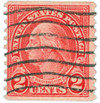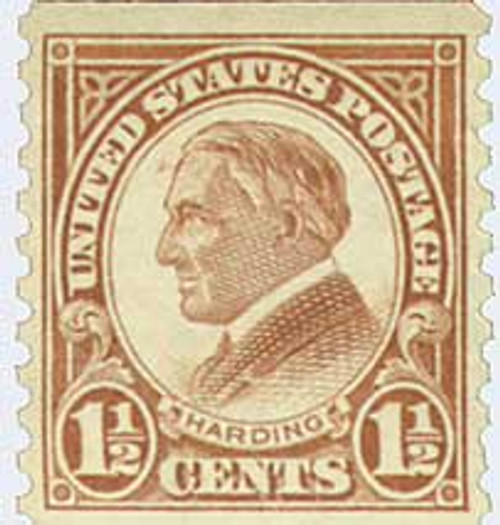
1929 2c Washington, carmine, coil
# 599A - 1929 2c Washington, carmine, coil
$12.00 - $1,800.00
U.S. #599A
Series of 1923-26 2¢ George Washington
Type II
Series of 1923-26 2¢ George Washington
Type II
Issue Date: March 1929
First City: Washington, D.C.
Quantity Issued: Unknown
Printed by: Bureau of Engraving and Printing
Printing Method: Rotary Press
Perforation: 10 Vertically
Color: Carmine
First City: Washington, D.C.
Quantity Issued: Unknown
Printed by: Bureau of Engraving and Printing
Printing Method: Rotary Press
Perforation: 10 Vertically
Color: Carmine
U.S. #599A was a variant that emerged six years after the original stamp (U.S. #599) was issued. The die plates were starting to wear down, and were re-cut to strengthen the image on the stamp. This resulted in alterations significant enough to establish #599A as a separate variant. The differences are explained below.
Type II
Series of 1923-26 stamps printed on Type II plates were distinguished from earlier, Type I plates by the following characteristics: The hair on Washington’s head has three heavy lines added. The scrollwork about the left “2” (called “acanthus”) is sharply defined from the outside border it overlaps. The rectangular box surrounding the circles in the bottom corners is more clearly defined.
Washington Enjoyed Free Franking
George Washington was extended the free franking privilege as a private citizen on April 28, 1784 – only the second person to have it (Ben Franklin was the first). That meant he could send mail for free by applying his signature. When Washington became U.S. President in 1789, he continued to use the franking privilege, even for official duties. However, the free franking privilege had not yet been officially granted to the executive branch of government. That wouldn’t come until February 20, 1792.
U.S. #599A
Series of 1923-26 2¢ George Washington
Type II
Series of 1923-26 2¢ George Washington
Type II
Issue Date: March 1929
First City: Washington, D.C.
Quantity Issued: Unknown
Printed by: Bureau of Engraving and Printing
Printing Method: Rotary Press
Perforation: 10 Vertically
Color: Carmine
First City: Washington, D.C.
Quantity Issued: Unknown
Printed by: Bureau of Engraving and Printing
Printing Method: Rotary Press
Perforation: 10 Vertically
Color: Carmine
U.S. #599A was a variant that emerged six years after the original stamp (U.S. #599) was issued. The die plates were starting to wear down, and were re-cut to strengthen the image on the stamp. This resulted in alterations significant enough to establish #599A as a separate variant. The differences are explained below.
Type II
Series of 1923-26 stamps printed on Type II plates were distinguished from earlier, Type I plates by the following characteristics: The hair on Washington’s head has three heavy lines added. The scrollwork about the left “2” (called “acanthus”) is sharply defined from the outside border it overlaps. The rectangular box surrounding the circles in the bottom corners is more clearly defined.
Washington Enjoyed Free Franking
George Washington was extended the free franking privilege as a private citizen on April 28, 1784 – only the second person to have it (Ben Franklin was the first). That meant he could send mail for free by applying his signature. When Washington became U.S. President in 1789, he continued to use the franking privilege, even for official duties. However, the free franking privilege had not yet been officially granted to the executive branch of government. That wouldn’t come until February 20, 1792.






















